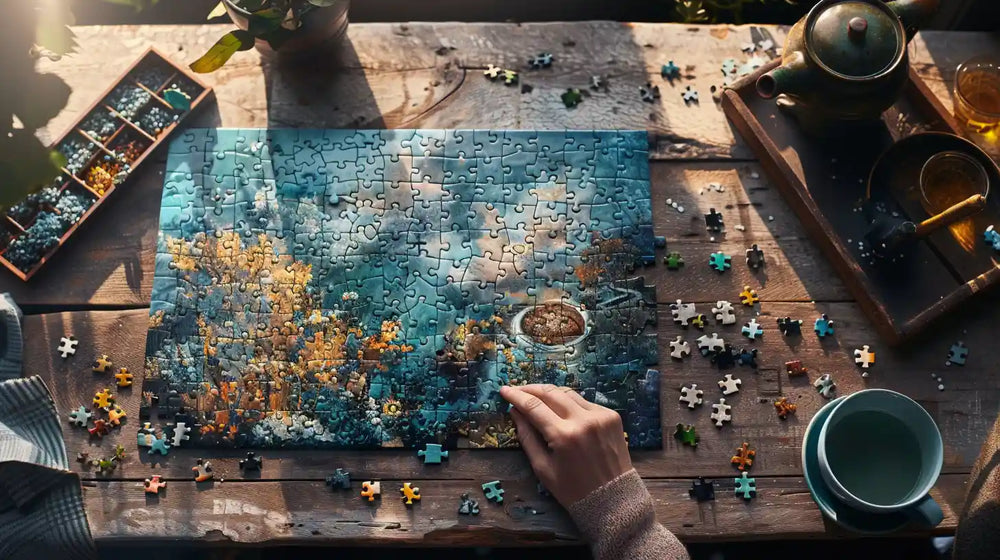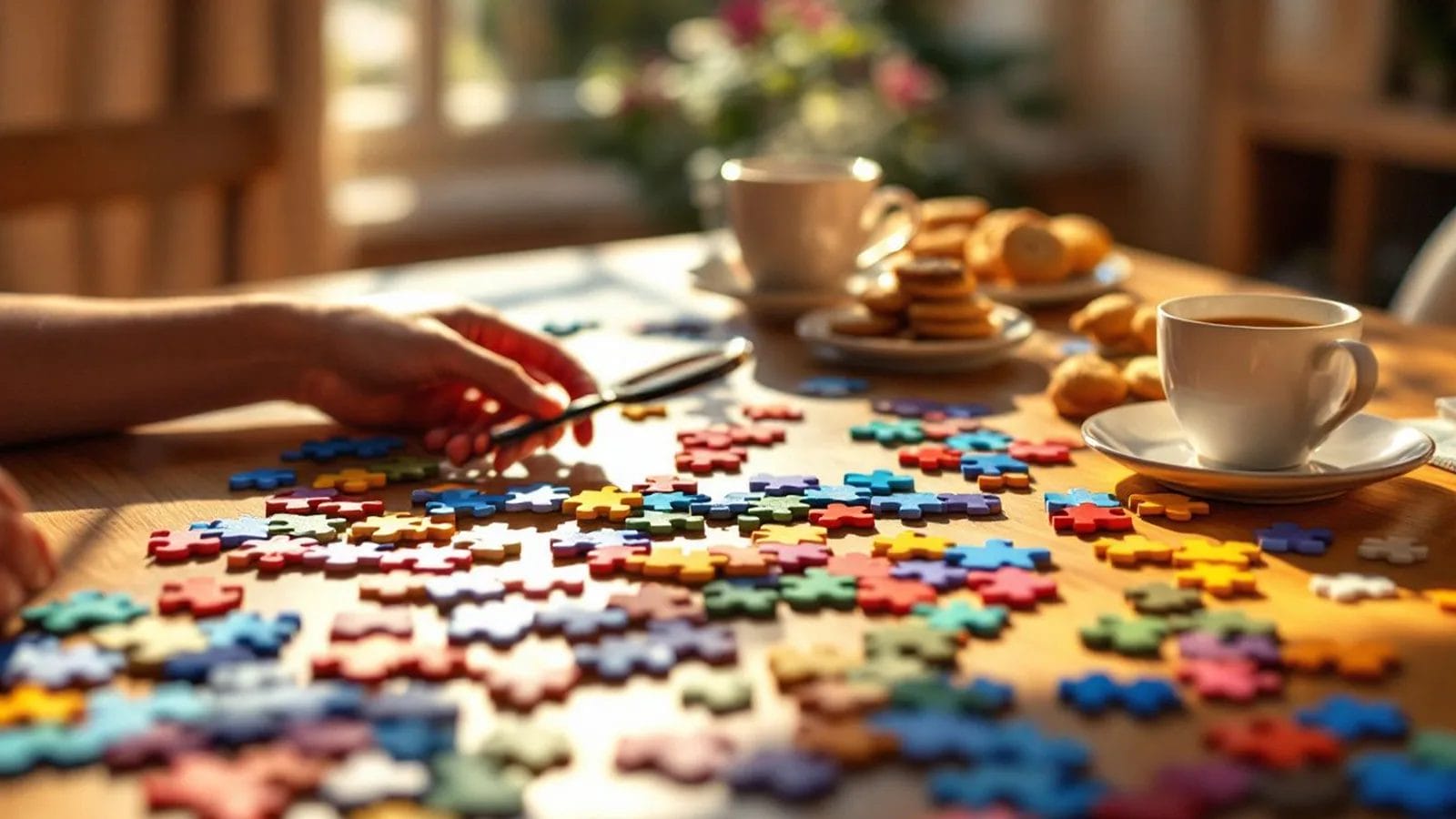
Jigsaw Puzzle Tips for Beginners: 10 Best Tips to Enhance Skills
Jigsaw puzzles are a delightful way to challenge your mind and unwind at the same time. For beginners, assembling hundreds or thousands of pieces can feel daunting. But with the proper techniques and a bit of patience, you can turn this enjoyable pastime into a rewarding experience.
Today, we’ll share essential tips to help novice puzzlers confidently navigate their first project. Whether you’re tackling a simple 100-piece puzzle or a complex design, these strategies will set you on the path to success.
Key Takeaways
- Designate a well-lit, comfortable workspace to enhance focus and reduce eyestrain.
- Start with 500-piece puzzles featuring vibrant imagery and standard shapes for easier handling.
- Sort pieces by color, pattern, and edge to streamline organization and assembly.
- Assemble the edge pieces first to establish the puzzle's framework before focusing on smaller sections.
- Take regular breaks to prevent mental fatigue and maintain motivation.
10 Best Jigsaw Puzzle Tips for Beginners

Starting a jigsaw puzzle can be both exciting and daunting, especially for newbies. Here are some strategies to help you get started.
1. Choose the Right Puzzle
Selecting the right puzzle is crucial for beginners. Start with puzzles that have 300-500 pieces and images with clear, distinct patterns or colors.
Avoid overly complex designs or those with similar colors, as they can be frustrating. As you gain confidence and skill, gradually progress to larger puzzles with more intricate designs.
2. Organize Your Workspace
A well-organized workspace can make a significant difference in your puzzle experience. Choose a spacious area, such as a dining room table or a dedicated puzzle board, where you can spread out your pieces comfortably.
Ensure the area is well-lit to reduce eye strain and keep distractions to a minimum. A clean workspace allows you to think clearly and work more efficiently.
3. Prepare Essential Tools
Invest in tools that enhance your puzzle-solving experience. A puzzle mat or board provides a stable surface for assembling your puzzle and makes it easy to transport if you need to move it.
Additionally, use trays or small containers to sort pieces by color, shape, or edge. These tools help keep everything organized and accessible, allowing you to focus on the puzzle itself.
4. Sort the Pieces
When you first open the puzzle box, take the time to flip all the pieces face up for better visibility. Sorting pieces is a vital step in the process.
Separate edge pieces from the inner pieces to create a clear framework. Then, sort the remaining pieces by color or pattern.
This organization will make it much easier to find the pieces you need as you progress.
5. Focus on Edge Pieces First
Starting with edge pieces is a classic strategy that provides structure to your puzzle. Assemble the border first, as this gives you a clear outline of what you're working with.
Once the border is complete, it becomes easier to visualize where the interior pieces will fit within that frame, guiding your assembly process.
6. Complete the Puzzle in Stages
Instead of tackling the entire puzzle at once, focus on completing smaller sections. This approach can boost your motivation and create a sense of accomplishment as you finish each part.
You might start with a specific color block or a prominent feature in the image. Completing sections one at a time helps reduce overwhelm and keeps your enthusiasm alive.
7. Maintain a Flexible Mindset
Puzzling can sometimes be frustrating, especially if you can't find the right piece. It's essential to stay calm and flexible. If you're stuck, step away for a moment or shift your focus to another section of the puzzle.
This break can rejuvenate your mind and allow you to return with fresh eyes, making it easier to identify where pieces might fit.
8. Use Visual References
The image on the puzzle box serves as an essential reference tool throughout your assembly process. Take a moment to study it carefully before beginning. Familiarize yourself with key features, colors, and patterns. Additionally, consider taking a photo of the box cover and keeping it nearby for quick reference as you work through the puzzle.
9. Take Regular Breaks to Avoid Fatigue
Long puzzle sessions can lead to mental fatigue and frustration. To maintain focus and enjoy the process, take regular breaks every 30-60 minutes. Use this time to stretch, hydrate, or simply step away from the puzzle for a moment. These breaks help refresh your mind and prevent burnout, allowing you to return with increased concentration.
10. Enjoy the Process Rather Than the Outcome
Remember that puzzling is not just about finishing but also about enjoying the journey. Embrace each piece you connect as a small victory. The satisfaction comes from solving challenges and witnessing the image come together piece by piece. Allow yourself to relax and savor the experience without stressing over how quickly you complete it.
What Types of Jigsaw Puzzles Are Suitable for Newbies?
To make a solid start, new puzzlers should opt for piece puzzles that have fewer than 500 pieces. These puzzles are a great way to build confidence and improve your skills without feeling overwhelmed.
Look for puzzles with high color variation and clear imagery. They make it easier to identify and fit pieces together. Standard shapes, like squares or rectangles, simplify the process, while round puzzles can be easier to handle and organize.
As you gain confidence, gradually progress to more complex puzzles with fewer colors and unconventional shapes.
How to Select a Puzzle Based on Your Interests
Choosing a puzzle that aligns with your interests can enhance your enjoyment and engagement.
Start by considering what themes resonate with you—nature, animals, or art. Such themes make the experience more personal and fulfilling.
Opt for puzzles with vibrant colors and clear images. They're visually appealing and, easier and more rewarding to assemble.
Conclusion
As you immerse yourself in the world of jigsaw puzzles, remember to embrace patience and creativity. Start with a clear workspace, sort your pieces, and rely on the image reference for guidance. Don't hesitate to take breaks to keep frustration at bay.
Using a puzzle mat can simplify the process, making it easy to pause and resume. Choose puzzles that captivate your interest, and you'll find the journey of piecing them together both rewarding and enjoyable.
FAQs
Is There a Trick to Doing Jigsaw Puzzles?
Yes. Sort pieces by color and edge types first. Build the border, then focus on distinct sections. Take breaks to maintain clarity, and use sorting trays to stay organized.
How Long Should a 1000 Piece Puzzle Take?
A 1000-piece puzzle should take 5 to 20 hours to complete. Your experience and the puzzle's complexity are key factors. Break it into 1-2-hour sessions to maintain focus and prevent fatigue.
How to Solve a Jigsaw Puzzle Step by Step?
Start by flipping all pieces face up. Separate edge pieces, build the border, and then sort by color and pattern. Focus on small sections, stay motivated, and take breaks. Identify unique connectors to enhance your puzzle-solving efficiency.